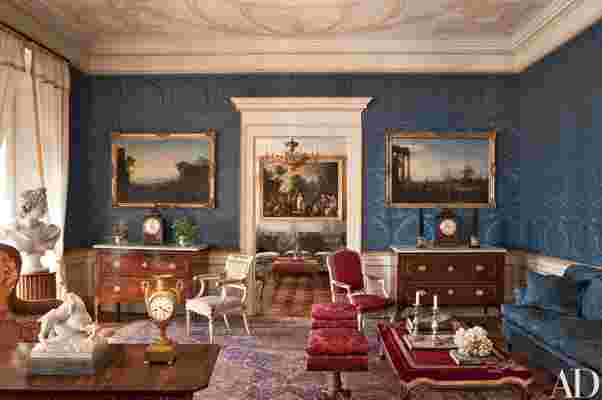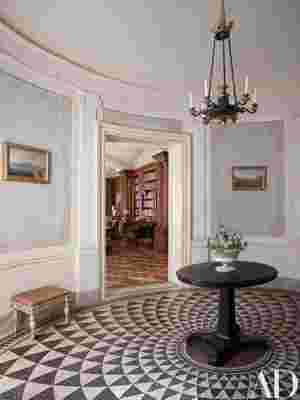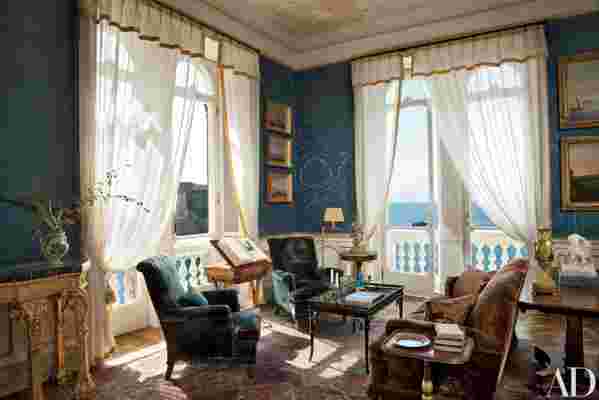This article originally appeared in the December 2011 issue of Architectural Digest.
Once a modest fishing village, the Lungomare district of Naples, Italy, has traded most of its salt-etched fishing boats for stylish restaurants and luxury shops. But one local treasure continues to hold its own: the medieval Castel dell’Ovo, or Egg Castle, so named because the poet Virgil is said to have placed a magical egg in its foundation. It was the views of this fortress, with Vesuvius a blur in the distance, that seduced a retired Neapolitan banker who lives in London to purchase a pied-à-terre in his hometown.
To renovate the three-bedroom apartment, he called on Laura Sartori Rimini and Roberto Peregalli, partners in Studio Peregalli , an acclaimed Milanese architecture and design firm. The financier had seen their work—rooms that were dreamlike evocations of aristocratic schemes fashionable centuries ago—for clients in England; he asked the team to give his Italian landscape paintings and objets d’art a worthy setting. Back then the flat was shabby and divided into tiny rooms. Today its formerly featureless ceilings have bloomed into soaring vaults, and its dark corners are now graceful curves. The fittings are new, but the effect, as with so many interiors produced by Studio Peregalli, is achingly nostalgic.
And inventive, too. In the entrance hall the designers demonstrated their gift for devising unexpected volumes within the most ordinary of shells. To amend a front door that opened awkwardly in a corner, Sartori Rimini and Peregalli did away with the corners altogether, creating an oval room paved with black-and-white mosaic tile and ringed with Ionic pilasters.
If these details conjure an Italy out of dusty books and gauzy remembrances, it is no wonder. The partners met 20 years ago in the orbit of the maestro of emotional interiors Renzo Mongiardino, a man often called the greatest decorator of the past century. Sartori Rimini was an architect fascinated by old buildings; Peregalli grew up in a Mongiardino-designed home and studied philosophy alongside decorative arts with his mentor’s encouragement. Undoubtedly Mongiardino’s wistful rooms and romantic stage sets are mapped into the collective unconscious of Studio Peregalli, but the designers see his legacy as more than an agglomeration of brilliant details. “He taught us to mix rigor with imagination,” Peregalli says, “and to fish into history for inspiration.”
The grandeur of bygone days, for instance, led to the creation of a capacious walnut-walled library just off the entrance hall. Its neoclassical-style cove ceiling, floating overhead like a billowing sail, is banded in an almond-green to match the room’s 18th-century Neapolitan consoles. “We like to play with vaults,” says Sartori Rimini, “which can transform the atmosphere of a space.” Underfoot is diamond-pattern parquet fashioned of cherry, walnut, and maple and artfully given “the patina of age,” Peregalli says.



The team left the living room ceiling flat, concluding that a simple box shape might better set off the room’s rich blues and golds, the colors of the Mediterranean coast. Here 18th-century furniture and antique Neapolitan seascapes glow in lamplight, but by day they are no match for the postcard-perfect views; Castel dell’Ovo is so close it seems one could touch it. When there is a breeze, the sheer-linen curtains tremble, allowing sunlight to surge over the deep blue damask-clad walls. Typical of Studio Peregalli, the damask was specially dyed for the project. This kind of bespoke work is a hallmark of the designers, who rely on Italian craftsmen for projects in Morocco, Switzerland, and the U.S.
Just past the living room is an elliptical salon for more intimate gatherings. This is both the last of the apartment’s public rooms and a spatial echo of the first. A secret door, barely visible to the casual glance, opens to a suite of private spaces: rooms for the client’s son and daughter when they visit, and a master bedroom whose salmon walls and fanciful painted wreaths give way to a grisaille bath that marries robust marbles to delicate, hand-painted stripes. As the designers note, that intriguing blend of bold gestures and exquisite details aptly illustrates the owner’s aesthetic.
The salon’s astonishing trompe l’oeil scene—which covers the walls and ceiling in the tradition of Neapolitan painted rooms—depicts a soaring treillage with a diaphanous countryside beyond. “It offers the fantasy that the apartment is unfinished,” Peregalli observes. And it embodies the spirit Italians call buttato lì, which could be translated as “tossed off.” This apparent insouciance, so cherished by the designers, actually evolves out of painstaking research and meticulous execution. “What we’ve done is an invention of the past,” Peregalli explains. Somewhere Signor Mongiardino is proudly nodding in agreement.
